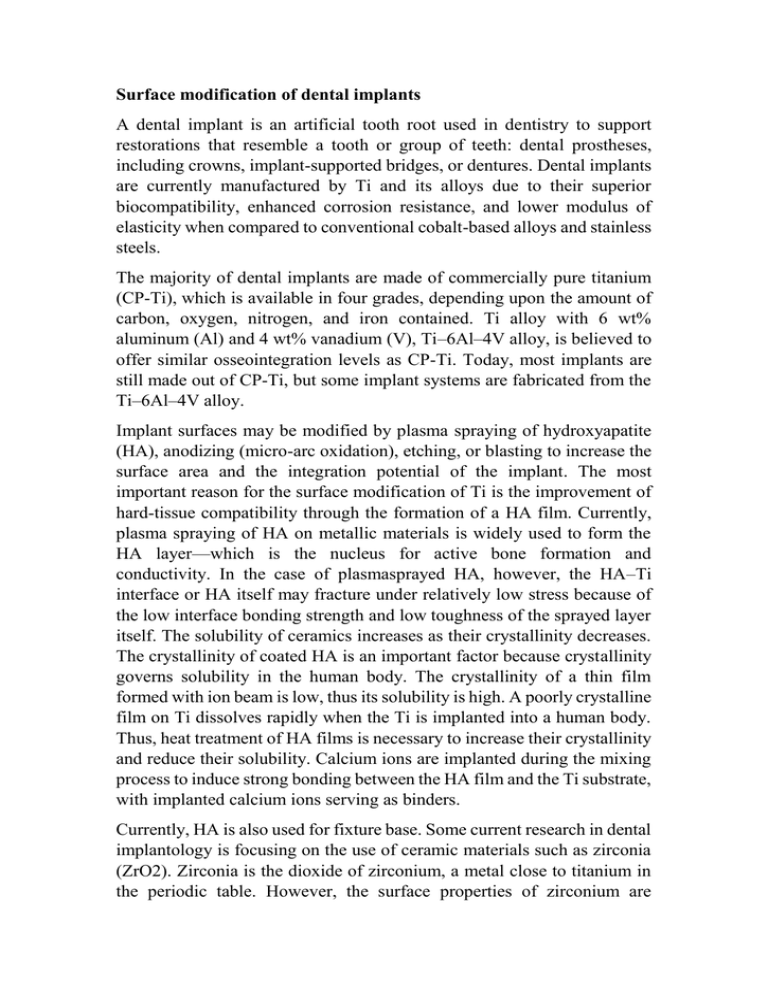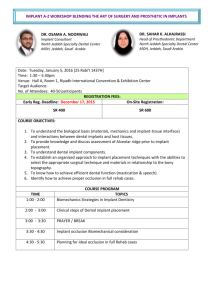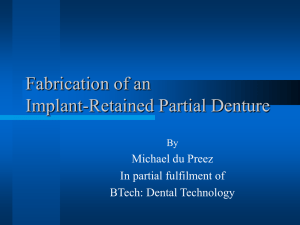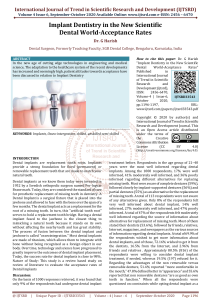Surface modification of dental implants
advertisement

Surface modification of dental implants A dental implant is an artificial tooth root used in dentistry to support restorations that resemble a tooth or group of teeth: dental prostheses, including crowns, implant-supported bridges, or dentures. Dental implants are currently manufactured by Ti and its alloys due to their superior biocompatibility, enhanced corrosion resistance, and lower modulus of elasticity when compared to conventional cobalt-based alloys and stainless steels. The majority of dental implants are made of commercially pure titanium (CP-Ti), which is available in four grades, depending upon the amount of carbon, oxygen, nitrogen, and iron contained. Ti alloy with 6 wt% aluminum (Al) and 4 wt% vanadium (V), Ti–6Al–4V alloy, is believed to offer similar osseointegration levels as CP-Ti. Today, most implants are still made out of CP-Ti, but some implant systems are fabricated from the Ti–6Al–4V alloy. Implant surfaces may be modified by plasma spraying of hydroxyapatite (HA), anodizing (micro-arc oxidation), etching, or blasting to increase the surface area and the integration potential of the implant. The most important reason for the surface modification of Ti is the improvement of hard-tissue compatibility through the formation of a HA film. Currently, plasma spraying of HA on metallic materials is widely used to form the HA layer—which is the nucleus for active bone formation and conductivity. In the case of plasmasprayed HA, however, the HA–Ti interface or HA itself may fracture under relatively low stress because of the low interface bonding strength and low toughness of the sprayed layer itself. The solubility of ceramics increases as their crystallinity decreases. The crystallinity of coated HA is an important factor because crystallinity governs solubility in the human body. The crystallinity of a thin film formed with ion beam is low, thus its solubility is high. A poorly crystalline film on Ti dissolves rapidly when the Ti is implanted into a human body. Thus, heat treatment of HA films is necessary to increase their crystallinity and reduce their solubility. Calcium ions are implanted during the mixing process to induce strong bonding between the HA film and the Ti substrate, with implanted calcium ions serving as binders. Currently, HA is also used for fixture base. Some current research in dental implantology is focusing on the use of ceramic materials such as zirconia (ZrO2). Zirconia is the dioxide of zirconium, a metal close to titanium in the periodic table. However, the surface properties of zirconium are different from those of Ti. Although generally having the same shape as Ti implants, zirconia, which has been used successfully for orthopedic surgery for a number of years, has the advantage of being more cosmetically esthetic owing to its bright tooth-like color. Defining Terms Biocompatibility: acceptance of an artificial implant by the surrounding tissues and as a whole, the implant should be compatible with tissue in terms of mechanical, chemical, surface, and pharmacological properties. In vitro In glass, as in a test tube, an in vitro test is one done in the laboratory, usually involving isolated tissues, organs, or cells. In vivo In the living body or organism. A test performed in a living organism. Osseointegration: A term indicating the ability of host bone tissues to form a functional, mechanically immobile interface with the implant. Bone cement: mixture of polymethylmethacrylate powder and methylmethacrylate monomer liquid to be used as a grouting material for the fixation of orthopedic joint implants. Plasms spray: A high-temperature process by which calcium-phosphate containing materials are coated onto a suitable implant substrate. Although the target material may be of high purity, the high –temperature softening process can dramatically affect and alter the resultant composition of the coating.











